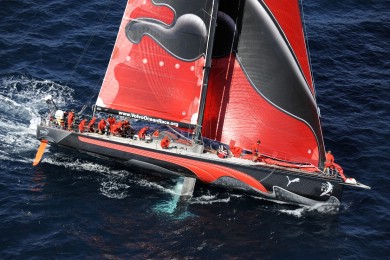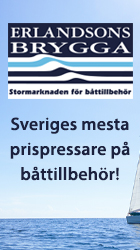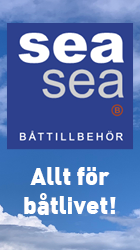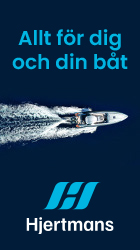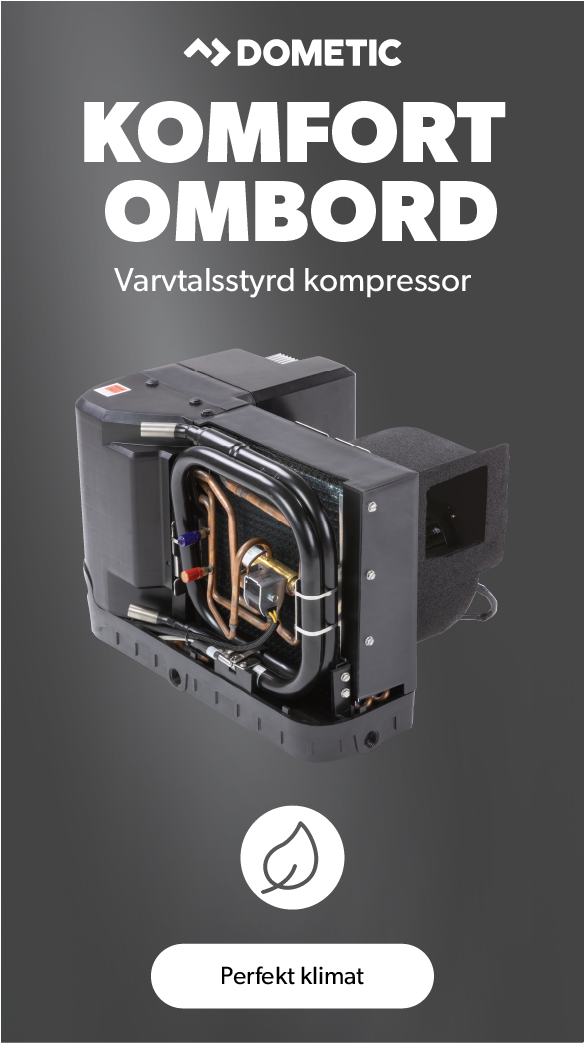Puma med skepparen Ken Read har tagit en knapp ledning i Volvo Ocean Race, som nu har passerat Kanarieöarna. Ericsson 4 ligger tvåa, ett par Nm efter Puma, medan Ericsson 3 är 37 Nm efter Puma. Det har skiftat snabbt mellan de två tätbåtarna och förändringarna kan bli många även de närmaste timmarna. Sista båten, Telefonica Blue, är över 100 Nm efter täten.
Här är dagens sammanfattande pressrelease på engelska:
Wednesday 15 October 2008 10:00:00 GMT
THE TEN ZULU REPORT, LEG 1, DAY 5
Green Dragon hit the StealthPlay button this morning at 04:00 – and disappeared. We won’t see them again for another 12 hours, at the 16:00 Position Report.
Ian Walker and his team are the first to use this new tactical weapon – an innovation for this edition of the Volvo Ocean Race. So what moves are they going to pull while they’re off the radar?
At 10:00 Zulu they had been in Stealth mode for six hours, and the rest of the fleet were in the transit lounge of the Canary Islands at the beginning of what could be a critical couple of days.
Almost everyone in the lead pack has had a go at the front in the last 24 hours: Telefonica Black at 13:00; Green Dragon at 16:00; Ericsson recapturing the lead at 19:00 – nothing between them as they hurtled down the track. Average speeds are high – we’re seeing 18, 19, 20 knots being sustained over an hour – smoking south in a northerly breeze that’s blowing at well over 20 knots.
Right now, PUMA and Ericsson 4 are leading the fleet, with over 30 miles to the next boat, Ericsson 3, thanks to their drive to the south. But here’s an idea for you – the DTL (Distance to Leader), isn’t the story at the moment, it’s all about positioning. To find out why, we need to back up to yesterday afternoon.
Scattered like slingshot
We left the fleet all on port gybe, headed slightly east of south, towards the coast of North Africa, which the previous 24 hours had taught us was where the strongest breeze was to be found. This nice tidy pattern didn’t last for long, and by 13:00 the fleet had scattered like slingshot. Telefonica Black gybed away from the leading pack first and headed west – grabbing the lead for the 13:00 report.
It was an interesting move, given that this came in from Bouwe Bekking on stablemate Telefonica Blue just before it was made – “Navigator, Simon Fisher and I are spending heaps of time behind the computer and looking into all the options. We don’t want to do anything crazy. Once you are behind, you are tempted to take bigger risks, but we are happy with any small cookie we can get.” After making losses, Bouwe eventually chose to tuck in behind the leading pair – but their frontline spinnaker for these conditions is shredded, and they are struggling right now.
Meanwhile, Ericsson 4 and PUMA were headed for the beach, with Ericsson 3, Team Russia and Delta Lloyd also intent on checking out the action inshore, as Ger O’Rourke put it in yesterday’s email, ‘Anyway the lads are happy as they reckon they may see some babes on the beach.’
By late afternoon, the boats had pretty much made their choices and set-up for the short-term – which was the transition of the Canary Islands. We’ve been saying for a couple of days that the Deckman for Windows weather routing put the optimum course right on the Moroccan coast, all the way past the Canaries, and now it was about to happen.
At 19:00 yesterday, the front row were strung out in a line from north-west to south-east. Taking the northerly, high road, were Green Dragon and Telefonica Black. In the middle was Ericsson 3, and to the south, Ericsson 4 and PUMA. And the distance between them, strung out across the ocean, was over 70 miles.
It’s time for ‘L’ word
OK, there’s no getting away from it, it’s time for the ‘L’ word – no, not Liberal – but Leverage. It’s one inescapable piece of sailing jargon/terminology, and it means much the same as it does in financial markets. It’s a measure of risk. And risk in sailing terms is measured by the distance between you and your competitors across the race course, perpendicular (at right angles) to where you’re going.
The greater the leverage, then the greater the risk of gain or loss as the wind shifts or the strength of it increases unevenly. That old basketball cliché – stay between the man and the hoop – applies equally to sailing. It’s hard to get past someone who’s directly in front of you – although not impossible as we saw on Day 2 with the Buffalo Gals move. But in general, staying on the direct course to the mark, with your competitors directly behind you, is about as safe a tactical situation as you can come up with in sailing.
And so far, that’s pretty much how it’s been played. We’ve not had much leverage – the fleet has been stuck in a two pretty tight bunches, with little lateral separation across the race track. But by the time the flurry of afternoon gybes was done, there was over 70 miles of leverage from wing-tip to wing-tip of the formation. And ahead lay the Canary Islands – high mountains, turbulent winds, local effects and a real spin of the roulette wheel.
So, how is this going to play out? Leaving out the Stealth mode-ing Green Dragon, Telefonica Black is the only boat that will go to windward of all the islands. Ericsson 3 look to have chosen a route right through the middle. Delta Lloyd and Team Russia started by gybing down the southern coasts of Lanzarote and Fuerteventura, pretty close in, with PUMA, Ericsson 4 and Telefonica Blue also going to leeward of all the islands, but set up further offshore.
Remember, Ericsson 4, with the vastly-experienced Torben Grael and Jules Salter having trained with these boats – and in these waters – for months.
And perhaps Kenny Read agrees – PUMA has been locked beside Ericsson 4 for the last 24 hours. In an email off the boat early this morning, he gave us some idea of how close the racing has been for these two. “I was just told that the TP52 Worlds are going on in Lanzarote … not only did we just sail right past that island, but did so in the middle of a gybing duel with E4 – with them about two boat lengths ahead of us at times. No matter how close the TP52 event is, my guess is that there won’t be any tighter racing than E4 and ourselves are having right now.”
Sails on the rail
Kenny went on to describe watching the boys on Ericsson 4 start to move their stack (sails on the rail) – in preparation for a gybe – with the night vision binoculars. How the game has changed … back in the day, the only clue you had was a feeble, bobbing little red or green navigation light.
Read (PUMA) and Grael (Ericsson 4) must be pretty confident that the breeze is going to hold for them until they are past the Canaries. It’s daylight, they have more than 20 knots of north-northeasterly breeze, and they are hammering along at average boat speeds that are in the high teens. They should travel around two hundred miles before it gets dark – when the cooling effect can soften the wind – and that ought to be enough to get them clear.
And those Data Centre numbers confirm that the southern boats have nothing to worry about right now. At 07:00 they had more breeze than our friends in the north, with 19-20 knots true wind speed (TWS) in comparison to Telefonica Black’s 15.8. But we’ll have to wait till tomorrow to find out whether the current gains hold through the whole transit of the islands.
But we mustn’t forget the long game – the bigger, longer term question is still all about positioning for the Doldrums. Telefonica Black have got themselves over 130 miles of leverage from PUMA and Ericsson 4. That’s a couple of degrees of longitude separation in the approach to the Doldrums, and that could convert to vastly different conditions in six days time when they hit the wall.
The Deckman for Windows weather routing has the optimum route (the thin red line) still hugging the coast until about half way between the Canary and Cape Verde Islands.
And the pedestrian crossing through the Doldrums looks to be best at about 20-22E, thanks to a low forming off Sierra Leone – that’s 300 to 400 miles east of the historical optimum. Right now my money is on the inshore boats, PUMA and Ericsson 4, to pick up the scoring gate points at Fernando de Noronha. There, that’s sticking my neck out.
The Ten Zulu Report (so called because it follows the 10:00 GMT fleet position report, and Zulu is the meteorologist’s name for GMT).
Länk: www.volvooceanrace.org


